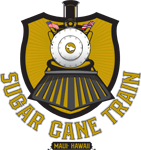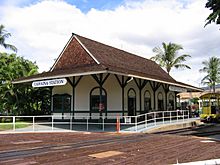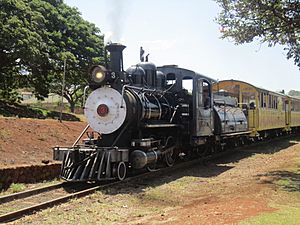Lahaina, Kaanapali and Pacific Railroad facts for kids
Quick facts for kids Lahaina, Kaanapali and Pacific Railroad (LKPRR) |
|
|---|---|
 |
|
| Locale | Lahaina, Hawaii |
| Preserved operations | |
| Owned by | Craig Hill |
| Reporting mark | LK&P |
| Length | 6 miles (9.7 km) |
| Preserved gauge | 3 ft (914 mm) |
| Commercial history | |
| Opened | 1970 |
| Closed | 2014 |
The Lahaina, Kaanapali and Pacific Railroad, also known as the Sugar Cane Train, was a special historic railway in Lāhainā, Hawaii. It used real steam locomotives to pull open-air passenger cars.
The train took passengers on a 6-mile, 40-minute journey. The track ran between the historic town of Lahaina and the Puukolii area, with a stop at the Kaanapali resort. During the ride, a guide would share stories about the sights. A highlight of the trip was crossing a high, curved wooden bridge, called a trestle. From the trestle, you could see amazing views of the West Maui Mountains and the nearby islands.
Today, the railroad is no longer running. All the trains and equipment are stored just north of Lahaina.
Contents
History of the Sugar Cane Train
A Train from the Past
The Sugar Cane Train's tracks followed a path that was once used to haul sugarcane. Long ago, trains carried the sugarcane from the fields to a sugar factory, called a mill, in Lahaina. At one time, the island of Maui had over 200 miles of railroad tracks for this purpose.
By the mid-1900s, trucks had replaced most of the trains for hauling sugar. In 1969, a man named A.W. "Mac" McKelvey decided to bring back a piece of this history. He started the Sugar Cane Train so people could experience what it was like during Hawaii's sugarcane plantation days. The train quickly became a popular attraction for visitors.
Closing and a New Hope
After many years of operation, the railroad faced money problems. It announced it would close on August 1, 2014. The entire railroad was put up for sale.
A few months later, a local resident named Craig Hill bought the Sugar Cane Train. He wanted to save the famous Lahaina attraction. For a few years, the train ran special "Holiday Express" trips during the Christmas season on a small part of the track.
The new owners planned to fix up the entire railway. They wanted to rebuild the locomotives and replace the old tracks with new ones. There were even plans to host weddings and run train rides in the evening. Everyone hoped the train would be fully running again by 2019, but this did not happen. In 2021, the entire railroad was listed for sale again.
Fires and an Uncertain Future
On August 8, 2023, a terrible wildfire swept through Lahaina. The fire destroyed the Lahaina train station, the special rotating platform for turning engines (called a turntable), and about half of the railroad tracks. Luckily, most of the locomotives and train cars were stored north of town and were not burned.
Sadly, on August 4, 2025, another fire in Kaanapali damaged or destroyed most of the train cars that had survived the first fire. As of today, the railroad sits abandoned, and its future is unknown.
The Famous Locomotives
The Sugar Cane Train had several unique engines, also called locomotives.
- No. 1 Anaka was a steam engine built in 1943. It was originally a simple-looking engine used for industrial work. The railroad's creators gave it a major makeover to look like a classic 1800s train engine. They added a wooden cab for the driver, a big smokestack, and a large headlight. They also added a separate car behind the engine, called a tender, to carry water and fuel.
- No. 3 Myrtle was built at the same time as Anaka. It was also changed to look like an old-fashioned engine, but from the early 1900s. It has a steel cab and a different style of tender. Its name and design were inspired by a real engine that worked on a Hawaiian sugarcane plantation long ago.
- No. 5 was the only engine owned by the railroad that had actually worked in Hawaii in the past. It ran on the island of Oahu until 1954. The railroad brought it back to Maui with plans to restore it. Unfortunately, this engine was badly damaged in the 2023 Lahaina fire.
- No. 45 Oahu is a diesel locomotive, which means it runs on diesel fuel instead of steam. It also came from the Oahu Railway.
Sights Along the Ride
When the train was running, passengers could see many interesting things:
- The Hahakea wooden trestle, a 325-foot-long bridge.
- A working wooden turntable in Lahaina, used to turn the locomotives around. This was destroyed in the 2023 fire.
- Beautiful views of the nearby islands of Lanai and Molokai.
- Views of the West Maui Mountains.
- The exciting "blowdown," where the engineer would release a huge cloud of steam from the locomotive.
See also
- List of heritage railroads in the United States








